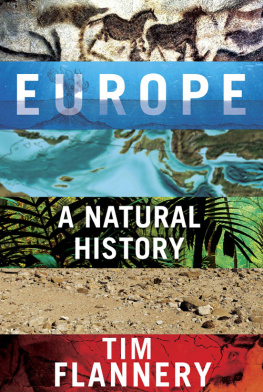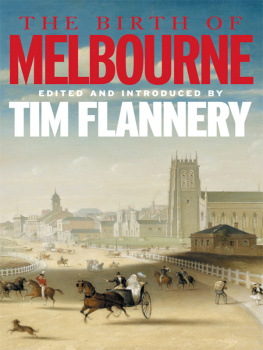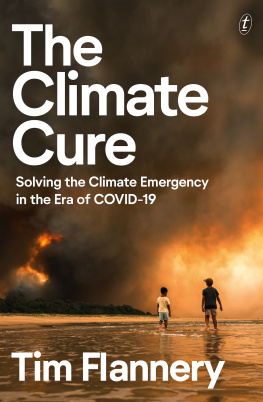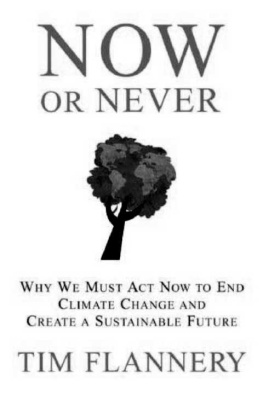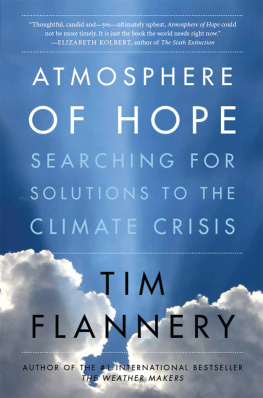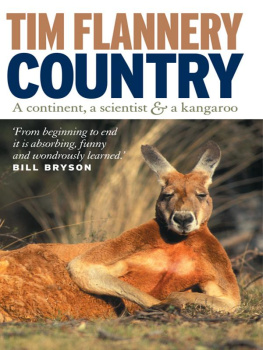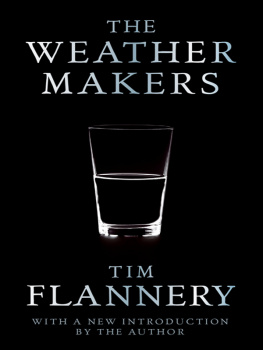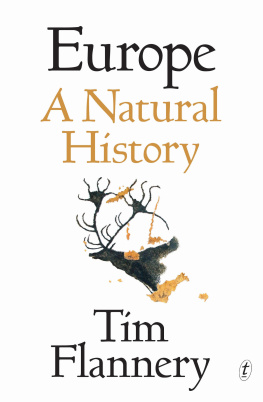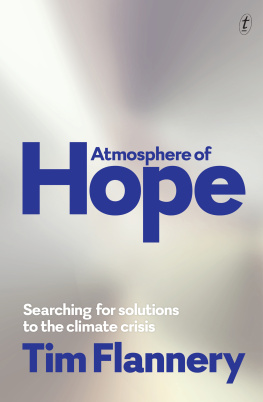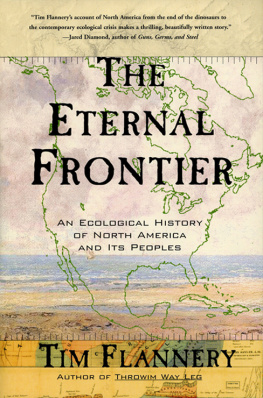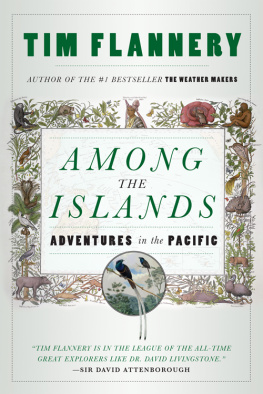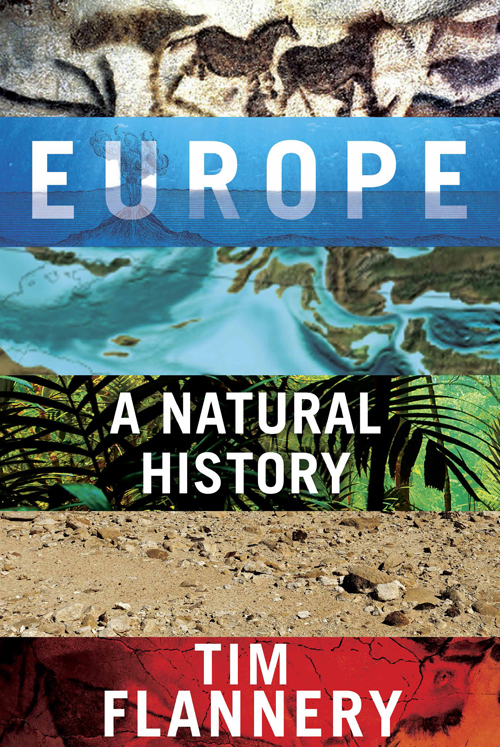The Weather Makers
Mammals of New Guinea
Tree Kangaroos: A Curious Natural History
with R. Martin, P. Schouten, and A. Szalay
Possums of the World: A Monograph of the Phalangeroidea with P. Schouten
Mammals of the South West Pacific and Moluccan Islands Watkin Tench, 1788 (ed.)
The Life and Adventures of John Nicol, Mariner (ed.)
Throwim Way Leg
The Birth of Sydney
Terra Australis: Matthew Flinders Great Adventures in the Circumnavigation of Australia (ed.)
The Eternal Frontier
The Explorers
A Gap in Nature with P. Schouten
Astonishing Animals with P. Schouten
Chasing Kangaroos
The Future Eaters
Now or Never
Here on Earth
Among the Islands: Adventures in the Pacific
An Explorers Notebook
Atmosphere of Hope
EUROPE
A NATURAL HISTORY
TIM FLANNERY
(with Luigi Boitani)
Copyright 2018 by Tim Flannery
Cover design by Gretchen Mergenthaler
Cover images, top to bottom: Lascaux cave painting, submarine volcano drawing alamy; map rendering of Europe during Cretaceous period Deep Time Maps/Colorado Plateau Geosystems Inc.; palm trees Shutterstock; sand Bigstock; Altamira cave painting alamy
Maps by Simon Barnard
Photos
Tim Flannery: , 1856. Entelodont skeleton by Peteron/Wikimedia Commons. Olms by Bostjan Burger via Lander/Wikipedia project. Oreopithecus bambolii skeleton in the Museo di Storia Naturale di Milano by Ghedoghedo/Creative Commons. Lion-man ivory statue by Thilo Parg/Wikimedia Commons, Licence CC BY-SA 3.0. Konik ponies at Oostvaardersplassen by E. M. Kintzel, I. Van Stokkum/Creative Commons.
All rights reserved. No part of this book may be reproduced in any form or by any electronic or mechanical means, including information storage and retrieval systems, without permission in writing from the publisher, except by a reviewer, who may quote brief passages in a review. Scanning, uploading, and electronic distribution of this book or the facilitation of such without the permission of the publisher is prohibited. Please purchase only authorized electronic editions, and do not participate in or encourage electronic piracy of copyrighted materials. Your support of the authors rights is appreciated. Any member of educational institutions wishing to photocopy part or all of the work for classroom use, or anthology, should send inquiries to Grove Atlantic, 154 West 14th Street, New York, NY 10011 or .
First published in Australia in 2018 by The Text Publishing Company
First Grove Atlantic edition: February 2019
Published simultaneously in Canada
Printed in Canada
ISBN 978-0-8021-2916-1
eISBN 978-0-8021-4695-3
Library of Congress cataloging in publication data is available for this title
Atlantic Monthly Press
an imprint of Grove Atlantic
154 West 14th Street
New York, NY 10011
Distributed by Publishers Group West
groveatlantic.com
19 20 21 22 10 9 8 7 6 5 4 3 2 1
To Colin Groves and Ken Aplin, life-long colleagues, and heroes of zoology.
A GEOLOGICAL TIME CHART
| Time Divisions | Important Fossil Deposits | Years Ago |
| Holocene Epoch |
| 11,764 |
| Pleistocene Epoch | Dmanisi |
| 2.6 million |
| Pliocene Epoch |
| 5.3 million |
| Miocene Epoch | Crete footprints
Hungarian iron mine | 23 million |
| Oligocene Epoch |
| 34 million |
| Eocene Epoch | Messel
Monte Bolca | 56 million |
| Palaeocene Epoch | Hainin |
| 66 million |
| Cretaceous Period | Hateg |
Natural histories encompass both the natural and the human worlds. This one seeks to answer three great questions. How was Europe formed? How was its extraordinary history discovered? And why did Europe come to be so important in the world? For those, like me, seeking answers it is fortunate that Europe has a great abundance of boneslayer upon layer of them, buried in rocks and sediments that extend all the way back to the beginning of bony animals. Europeans have also left an exceptionally rich trove of natural-history observations: from the works of Herodotus and Pliny to those of the English naturalists Robert Plot and Gilbert White. Europe is also where the investigation of the deep past began. The first geological map, the first palaeobiological studies and the first reconstructions of dinosaurs were all made in Europe. And over the past few years a revolution in research, driven by powerful new DNA studies, along with astonishing discoveries in palaeontology, has enabled a profound reinterpretation of the continents past.
This history begins around 100 million years ago, at the moment of Europes conceptionthe moment when the first distinctively European organisms evolved. Earths crust is composed of tectonic plates that move imperceptibly slowly across the globe, and upon which the continents ride. Most continents originated in the splitting of ancient supercontinents. But Europe began as an island archipelago, and its conception involved the geological interactions of three continental parentsAsia, North America and Africa. Together, those continents comprise about two-thirds of the land on Earth, and because Europe has acted as a bridge between these landmasses, it has
Europe is a place where evolution proceeds rapidlya place in the vanguard of global change. But even deep in the age of dinosaurs, Europe had special characteristics that shaped the evolution of its inhabitants. Some of these characteristics continue to exert influence today. In fact, some of Europes contemporary human dilemmas result from those characteristics.
Defining Europe is a slippery undertaking. Its diversity, evolutionary history and shifting borders make the place almost protean. Yet, paradoxically, Europe is immediately recognisable. With its distinctive human landscapes, once-great forests, Mediterranean coasts and Alpine vistaswe all know Europe when we see it. And the Europeans themselves, with their castles, towns and unmistakable music, are every bit as instantly recognisable. Moreover, it is important to recognise that Europeans share a highly influential dreamtimein the ancient worlds of Greece and Rome. Even Europeans whose forebears were never part of this classical world claim it as their own, looking to it for knowledge and inspiration.
So what is Europe, and what does it mean to be European? Contemporary Europe is not a continent in any real geographical sense. So defined, Turkey is part of Europe, but Israel is not: the rocks of Turkey share a common history with the rest of Europe, while Israels rocks originate in Africa.
I am not Europeanin a political sense at least. I was born in the antipodesEuropes oppositeas the Europeans once called Australia. But corporeally I am as European as the Queen of England (who, incidentally, is ethnically German). The history of Europes wars and monarchs were drilled into me as a child, but I was taught next to nothing about Australias trees and landscapes. Perhaps this contradiction triggered my curiosity. Whatever the case, my search for Europe began long ago, before I had ever touched European soil.

